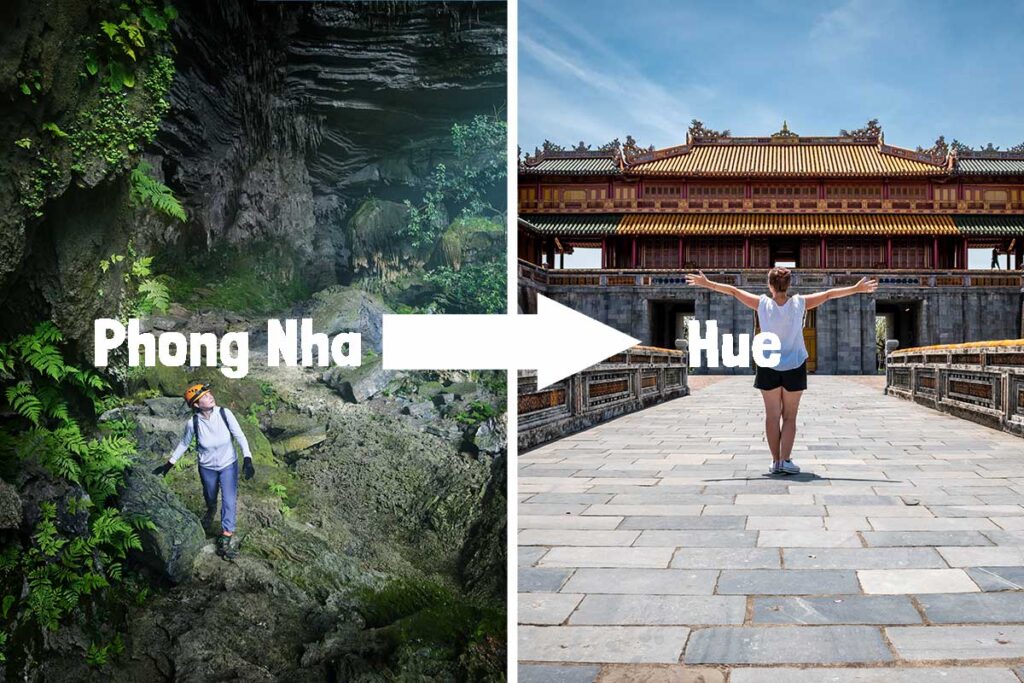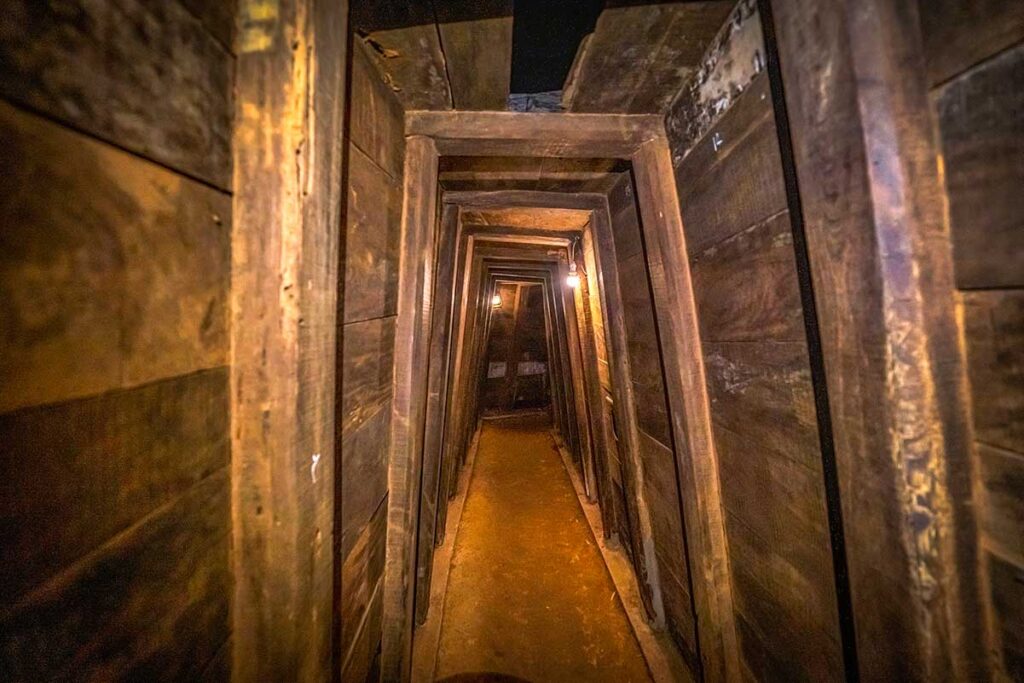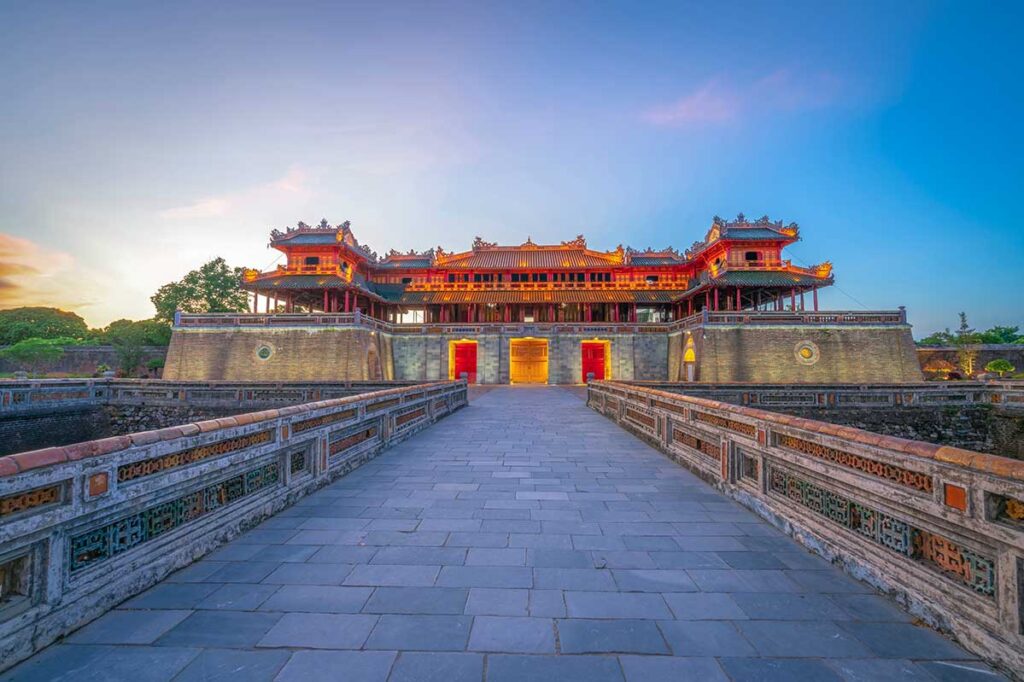About the route from Phong Nha to Hue
Traveling from Phong Nha to Hue covers a distance of around 210 km, connecting the caves and karst landscapes of Phong Nha-Ke Bang National Park with the imperial monuments of Hue. Phong Nha itself has no airport or train station, so the nearest transport hub is Dong Hoi, 45 km away. Hue is more accessible, with both a train station and an airport. By road, you can take the Ho Chi Minh Highway, the coastal QL1A, or the partially completed expressway (since 2025). Using the expressway, the journey takes about 3.5 hours; via the main highway, about 4 hours. Once the expressway is fully completed, travel time will drop to under 3 hours.
The DMZ on the Route
The Vietnamese Demilitarized Zone (DMZ) sits roughly halfway between Phong Nha and Hue and was a major frontline during the Vietnam War. While it’s not visible from the expressway, the QL1A and certain backroads pass close to or through historic sites, making it possible to include them in your trip.
What is the DMZ?
The DMZ was the dividing line between North and South Vietnam from 1954 to 1975, centered along the 17th parallel. Despite its name, it was one of the most heavily militarized areas during the war, with intense fighting and heavy bombing.
Sights to visit in the DMZ
Common stops (minimal detour):
- Hien Luong Bridge – Painted half red and half yellow to mark the former border, this bridge became a symbol of Vietnam’s division and later reunification.
- Vinh Moc Tunnels – An extensive underground network where an entire village lived to avoid bombings, complete with living quarters and meeting rooms.
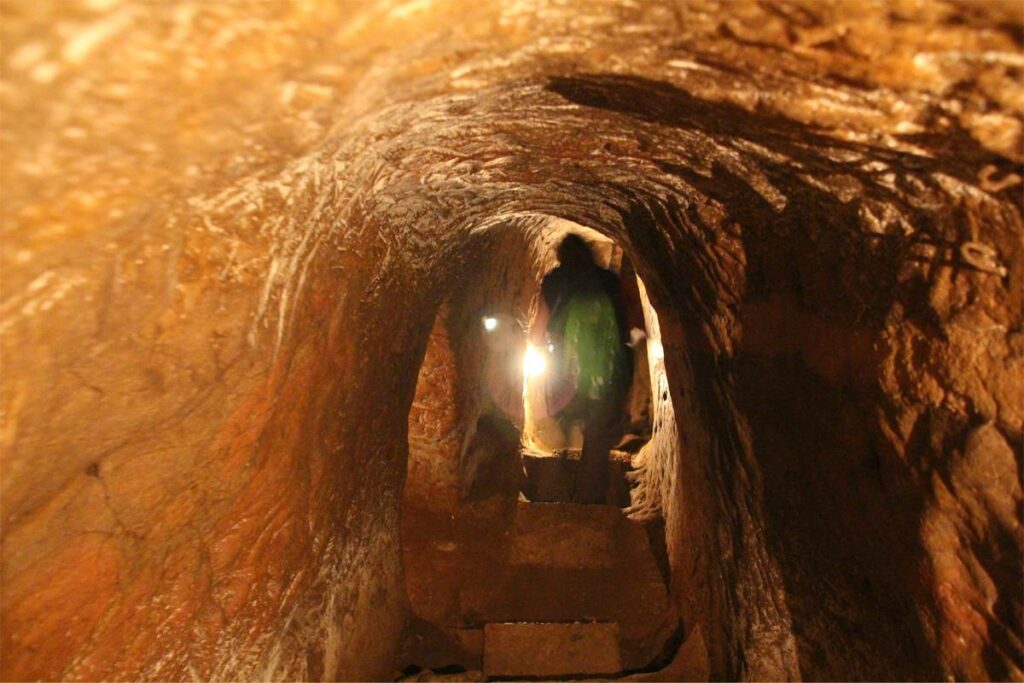
With extra detour:
- Khe Sanh Combat Base – Former US Marine base near the Laos border, now an open-air museum with aircraft, bunkers, and war relics.
- Mine Action Visitor Center – Educational center about unexploded ordnance and ongoing clearance projects in Quang Tri Province.
- Truong Son National Cemetery – The largest war cemetery in Vietnam, honoring tens of thousands of North Vietnamese soldiers who died in the southern battlefields.
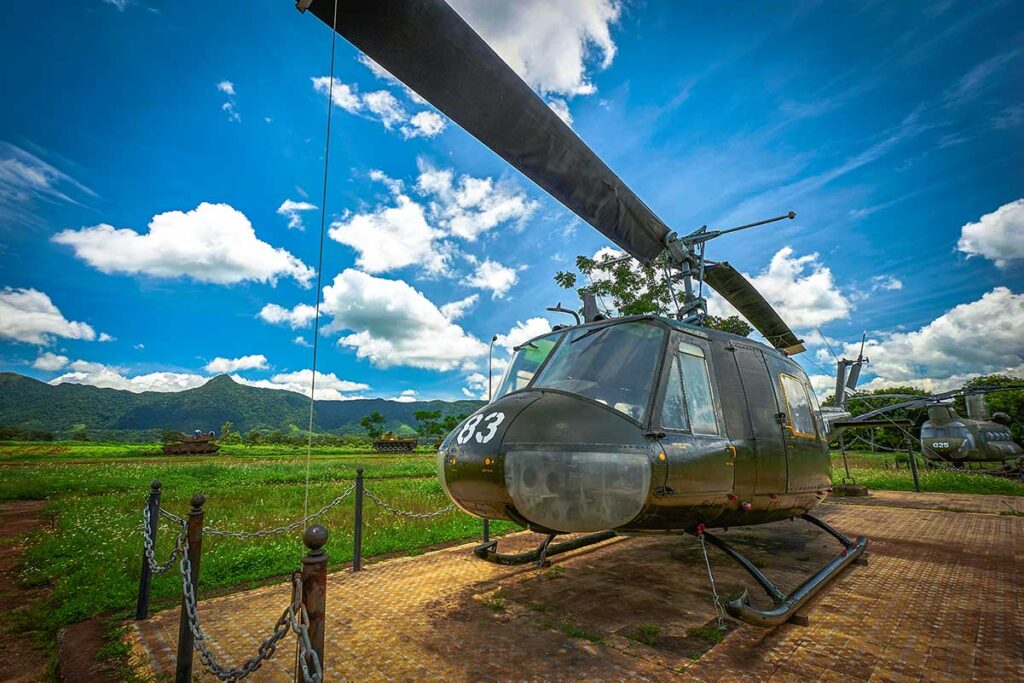
Option 1 – Sightseeing transfer through the DMZ (Most Recommended)
A sightseeing transfer from Phong Nha to Hue through the DMZ is the ideal way to combine your journey with a deeper look into Vietnam’s wartime history. This private, door-to-door service picks you up from your hotel in Phong Nha and drops you off directly at your accommodation in Hue, with several planned stops along the way.
Typical itineraries include Hien Luong Bridge and Vinh Moc Tunnels, while those with more time can add extended DMZ sites such as Khe Sanh Combat Base, the Mine Action Visitor Center, or Truong Son National Cemetery. Keep in mind that drivers are not always licensed guides, so if you want detailed historical explanations, it’s worth arranging a professional guide or using the on-site guides available at some attractions.
What’s Included
- Private vehicle and driver
- Fuel costs
- Road tolls
- Parking fees
What’s not included
- Entrance fees for sights (generally inexpensive, around 2 USD per person)
- Meals during the journey
- Licensed guide services (optional, at an extra cost)
Phong Nha – Hue: DMZ Sightseeing Transfer to Vietnam War Sights
- Highlights , Hien Luong Bridge, Vinh Moc Tunnels, optional; Khe Sanh Combat Base and Highway 9 Cemetery.
- Includes Private car, hotel pickup/drop-off, and flexible timing for each stop.
Option 2 – Multi-day Easy Rider Trip
What are Easy Riders?
Easy Riders are experienced local motorbike drivers who also act as guides, offering scenic, flexible road trips that go beyond the main highways. They specialize in showing travelers lesser-known areas, stopping frequently for viewpoints, local encounters, and cultural experiences along the way.
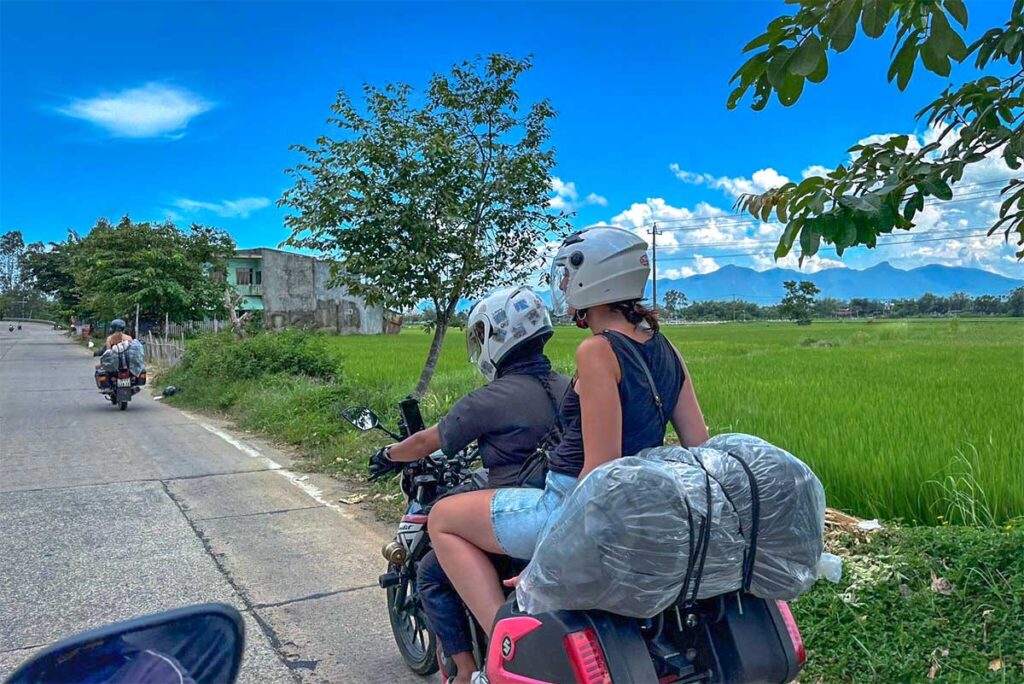
How it works
A multi-day Easy Rider trip from Phong Nha to Hue typically takes two or three days, although many travelers choose to continue further south to Hoi An. The route follows quiet backroads through rural countryside, minority villages, and notable war history sites, offering a much richer journey than direct transfers. You’ll ride as a passenger on the back of a motorbike, while your driver handles navigation and safety. Luggage is strapped securely to the bike, and there are plenty of stops for photos, meals, and exploration.
Good to know
- Always confirm what’s included in the price—some trips include meals, accommodation, and entrance fees, while others do not.
- Accommodation on the route is usually in local guesthouses or small hotels.
- The ride is more immersive and adventurous than traveling by car, but less comfortable for long distances, especially in bad weather.
- For safety and comfort, only choose Easy Riders with good reviews and proper helmets for both rider and passenger.
Option 3 – Bus
How it works
Traveling from Phong Nha to Hue by bus is a straightforward and budget-friendly choice. You don’t need to travel to Dong Hoi first, as most buses running the north–south route make a scheduled stop in Phong Nha town. The journey takes around 4 to 4.5 hours, depending on traffic and the number of pick-ups along the way.
Bus types
- Standard sleeper buses – Available for both day and night departures, these have reclining sleeper-style berths. While night buses operate this route, the short travel time means you won’t get a full night’s sleep.
- VIP cabin buses – Offer individual enclosed pods with more space and privacy, making them a comfortable upgrade for a small extra cost.
Prices & Booking
- Price range: 250,000–350,000 VND, depending on bus type and operator.
- How to book:
- Online via platforms such as 12Go or Vexere for easy comparison and seat selection.
- Through your accommodation in Phong Nha, which may charge a small extra fee but will arrange pick-up or direct you to the correct boarding point.
Option 4 – Train from Dong Hoi
How it works
If you want a scenic and relaxed way to travel from Phong Nha to Hue, the train is a great choice. Phong Nha is a small tourist town inside a remote national park and does not have its own train station. The nearest station is in Dong Hoi, about 45 km away. You’ll first need to get there by taxi, private car, or local bus (tip: read our guide about traveling between Phong Nha and Dong Hoi for details).
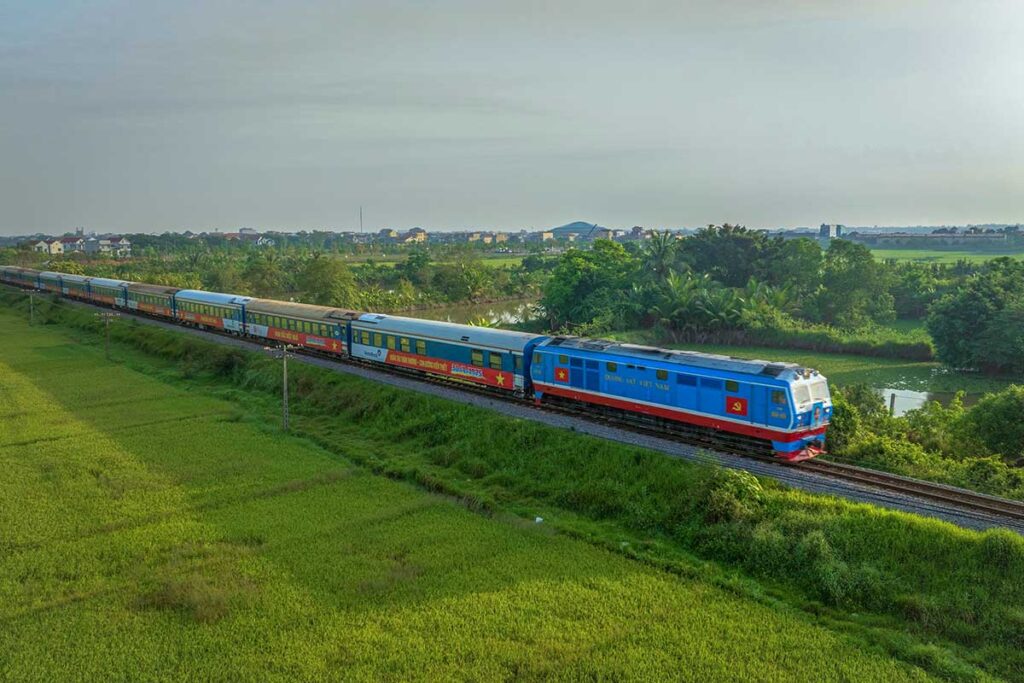
From Dong Hoi, you can take the train south to Hue. The journey takes around 3 to 3.5 hours and passes through a mix of rice fields, small villages, and, in the right season, lush green landscapes. The views are more varied than traveling by road, making this a rewarding option for those who enjoy watching the scenery roll by.
Recommended seats
- Soft seat – Comfortable and affordable, with decent legroom and good views from the large windows.
- Soft sleeper (4-berth) – Offers more privacy and quiet, especially useful if you want to relax or nap during the trip. Pro tip: Even for a short daytime journey, you can book all four berths in a cabin for exclusive use if you’re traveling as a couple or small group.
Option 5 – Private Car from Phong Nha to Hue (No Sightseeing)
How it works
A private car from Phong Nha to Hue is the fastest and most flexible option if you’re not planning to stop at the DMZ or other sights along the way. It works much like the sightseeing transfer in Option 1, but without detours — simply a direct, door-to-door ride.
This is ideal if you’re short on time, not interested in war history sites, or would rather skip enclosed places like the Vinh Moc Tunnels if you have claustrophobia. The journey takes around 4 hours via the main highway or slightly less using the partial expressway.
Book a Private Car with Driver
Enjoy a direct, comfortable transfer from Phong Nha to Hue with an experienced local driver. Perfect for travelers who value speed, privacy, and flexibility in departure times.
Tips for traveling from Phong Nha to Hue
How long to spend in Hue
Most travelers need at least one full day in Hue to see the major highlights, such as the Imperial City, Thien Mu Pagoda, and a royal tomb or two. If you’re passionate about the history of Vietnam’s dynasties, you could easily spend several days exploring, especially if you also include side trips like Bach Ma National Park or local villages.
Where to go next
Coming from Phong Nha to Hue means you’re traveling south, so these are the most natural onward stops:
- Da Nang – A modern coastal city known for its long sandy beaches and the Marble Mountains. Many travelers choose to get there via the scenic Hai Van Pass instead of taking a direct transfer, for spectacular ocean and mountain views.
- Hoi An – A UNESCO-listed ancient town famous for its well-preserved architecture, lantern-lit streets, and tailoring shops. It’s often combined with a visit to Da Nang, as they are just 30 km apart.
- Ho Chi Minh City – Vietnam’s largest and busiest city, known for its French colonial landmarks, vibrant street food scene, and historic sites from the Vietnam War. The fastest way to get there from Hue is by flight.
Hue travel guide
Hue is best known as Vietnam’s former imperial capital, home to the UNESCO-listed Complex of Hue Monuments. Here you can explore the Imperial City, royal tombs, ancient pagodas, and riverside landscapes. For more details on what to see and do, check out our full Hue travel guide.
